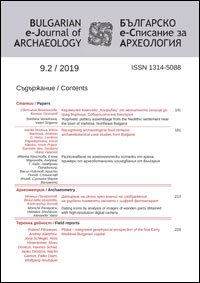Recognising archaeological food remains: archaeobotanical case studies from Bulgaria
Recognising archaeological food remains: archaeobotanical case studies from Bulgaria
Author(s): Ivanka Hristova, Elena Marinova, Andreas Heiss, Lambrini Papadopoulou, Vassil Nikolov, Hristo Popov, Stanislav Iliev, Soultana Maria ValamotiSubject(s): Archaeology
Published by: Асоциация на българските археолози
Keywords: Cereal food remains; plant macroremains; Scanning Electron Microscopy (SEM); Southeast Europe; Early Neolithic – Early Iron Age;
Summary/Abstract: The paper discusses possible evidence for cereal food from seven Bulgarian archaeological sites spanning the Early Neolithic to the Early Iron Age (6th millennium BC – 1st millennium BC). It aims to increase the awareness of excavators towards such finds and to present the methods for collecting and extracting such remains from archaeological layers and their laboratory analysis. The studied remains are mainly cereal fragments, agglomerations of fragments or amorphous/ porous masses with or without visible plant tissues. They were directly collected from vessel contents or derived by means of flotation from bulk samples taken from floor layers close to fireplaces/ cooking installations. The microscopic structure of the food remains is observed and described at plant tissue level under low magnification binocular, microscope with reflected light and Scanning Electron Microscope (SEM). These optical examinations were applied in order to detect alterations of the microstructure of the possible food remains and hence to trace the possible ways of food preparation. All the cereal food remains from the Neolithic/Chalcolithic period represent coarsely ground cereals, while the later ones (Late Bronze Age and Early Iron Age) have characteristics of finely ground cereal products and may suggest the introduction of new cooking/ baking techniques as well as shifts in food processing practices. Based on their field experience and research results the authors strongly recommend careful sampling and documentation of any charred crusts recognisable as such in vessel contents, and deposits around installations like ovens and fireplaces, which could be related to daily food preparation or ritual offerings. Such systematic study of archaeological food remains will facilitate obtaining reliable information about food preparation and consumption in the past.
Journal: Българско е-Списание за Археология
- Issue Year: 9/2019
- Issue No: 2
- Page Range: 181-211
- Page Count: 31
- Language: English

